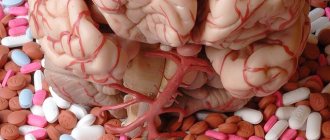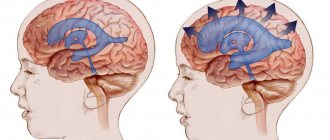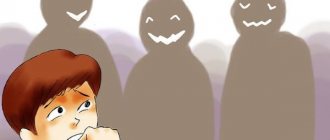Dysarthria in children.
Dysarthria in children is one of the types of speech disorders that occurs due to damage to the central nervous system. The most obvious disorders of this disease are changes in intonation, tempo and rhythm of speech, as well as a violation of voice formation and a disorder of articulation of sounds.
Children who suffer from dysarthria have great difficulty chewing and swallowing. They sometimes have difficulty buttoning clothes, hopping on one leg, or cutting with scissors. It is also difficult for them to write, so they study in specialized schools. Very often there are contradictions between neurologists and speech therapists regarding dysarthria. If a neurologist does not see obvious disturbances in the function of the cranial nerves, he cannot call the speech disorder dysarthria. This question is almost a stumbling block between neurologists and speech therapists. This is due to the fact that a neurologist, after making a diagnosis of dysarthria, is obliged to carry out serious therapy for the treatment of brainstem disorders, although such disorders (excluding dysarthria) do not seem to be noticeable. The medulla oblongata, as well as the cervical spinal cord, often experiences hypoxia during childbirth. This leads to a sharp decrease in motor units in the nerve nuclei responsible for articulation. During a neurological examination, the child adequately performs all tests, but cannot cope properly with articulation, because it is necessary to perform complex and fast movements that are beyond the strength of weakened muscles.
About the disease
Dysarthria is a disorder of speech skills due to damage to the speech motor system. The localization of the pathological process leading to the problem can develop at different levels of the nervous system responsible for the formation of sounds and the logical order of the story:
- nuclei of the cranial nerves responsible for the nervous control of the tongue, lips, soft palate, etc.;
- pathways between the cortex and cerebral nuclei;
- subcortical centers;
- the cerebellum and pathways, pathways from and to it;
- cerebral cortex.
The diagnosis is carried out simultaneously by a neurologist (determines the level of topical damage to the nervous system and the nature of the pathological process) and a speech therapist (determines the degree of speech disorders in order to make a correction prognosis).
Treatment is aimed at eliminating or stabilizing the background pathology that led to speech disorders, as well as articulatory correction.
Causes of dysarthria
1. Organic damage to the central nervous system as a result of the influence of various unfavorable factors on the developing brain of a child in the prenatal and early periods of development. Most often, these are intrauterine lesions that are the result of acute, chronic infections, oxygen deficiency (hypoxia), intoxication, toxicosis of pregnancy and a number of other factors that create conditions for the occurrence of birth trauma. In a significant number of such cases, asphyxia occurs during childbirth and the child is born premature. 2. The cause of dysarthria may be Rh factor incompatibility. 3. Dysarthria occurs somewhat less frequently under the influence of infectious diseases of the nervous system in the first years of a child’s life. Dysarthria is often observed in children suffering from cerebral palsy (CP). According to E.M. Mastyukova, dysarthria with cerebral palsy manifests itself in 65-85% of cases. Classification of clinical forms of dysarthria Classification of clinical forms of dysarthria is based on identifying different locations of brain damage. Children with various forms of dysarthria differ from each other in specific defects in sound pronunciation, voice, and articulatory motor skills, require different speech therapy techniques and can be corrected to varying degrees.
Forms of dysarthria
Diagnostics
Attentive parents may notice symptoms of dysarthria in a child in the first year of life. Children in infancy make it clear to their families that something is bothering them and what they want by shouting loudly and loudly.
If this is not the case or the cry is muffled and weak, we can assume insufficient development of the neuromuscular system of the articulatory apparatus. Also, the mother should be wary of: a weak sucking reflex and improper latching of the breast, difficulties in swallowing liquids (milk constantly leaks from the mouth and nose during feeding). If, in addition to the symptoms, there is no interest in the outside world, there are problems with breathing, chewing food, drinking from a cup - this indicates pseudobulbar syndrome, which manifests itself at an early age.
Children with a severe history of the fetal, perinatal and labor periods are observed by a neurologist during the first year of life. If there are no pronounced deviations in physical and intellectual development, then the child may be removed from the register; control and responsibility for the life, health and development of the child lies with the parents.
During the gradual development of speech skills, problems may appear, so you should contact a speech therapist, who can send a neurologist for additional consultation, he will determine the cause of the deviation, but cannot yet make a diagnosis. Perhaps many pathologies will be corrected by the age of 4-5 with the help of compensatory functions of the brain.
If restoration of articulation has not occurred, additional deviations in speech and motor skills are identified that do not allow normal learning in a general education institution, the doctor makes a diagnosis of “dysarthria” and gives recommendations for treatment. The specialist works with the child, correcting his speech. Parents and a speech pathologist help the child develop missing skills with the help of speech therapy massage for dysarthria.
Bulbar dysarthria
Bulbar dysarthria (from the Latin bulbus - a bulb, the shape of which is the medulla oblongata) occurs when there is a disease (inflammation) or tumor of the medulla oblongata. In this case, the nuclei of the motor cranial nerves located there (glossopharyngeal, vagus and sublingual, sometimes trigeminal and facial) are destroyed. Characteristic is paralysis or paresis of the muscles of the pharynx, larynx, tongue, and soft palate. A child with a similar defect has difficulty swallowing solid and liquid food and has difficulty chewing. Insufficient mobility of the vocal folds and soft palate leads to specific voice disorders: it becomes weak and nasal. Voiced sounds are not realized in speech. Paresis of the muscles of the soft palate leads to the free passage of exhaled air through the nose, and all sounds acquire a pronounced nasal (nasal) tone. In children with the described form of dysarthria, atrophy of the muscles of the tongue and pharynx is observed, and muscle tone also decreases (atonia). The paretic state of the tongue muscles causes numerous distortions in sound pronunciation. Speech is slurred, extremely unclear, slow. The face of a child with tabloid dysarthria is amicable.
Symptoms and classification
Dysarthria can manifest itself in both mild and pronounced forms. This depends on the degree of innervation disturbance and on the location of the damaged area of the central or peripheral nervous system. All disorders can occur with an increase or decrease in muscle tone of the speech apparatus. Severe cases are characterized by the following symptoms:
- muscle hypertonicity - constant tension of the tongue, face and neck, tightly closed lips, which limits the mobility of the speech apparatus;
- muscle hypotonicity - in such patients the mouth is constantly slightly open, the tongue is relaxed and cannot perform the movements necessary to pronounce sounds, involuntary salivation may occur;
- dystonia - at rest, the muscles remain completely relaxed, but when trying to reproduce sounds, they experience spastic contraction and a sharp increase in tone.
It is difficult to track pathological changes at home, especially if the disease occurs in an erased form. However, treatment is most effective in the early stages, which is why doctors at the Clinical Institute of the Brain recommend that preschool children undergo preventive examinations with a speech therapist. If speech defects are not detected in time, the condition can gradually progress.
Clinical picture
Dysarthria is characterized by any speech defects. Their severity depends on the form and degree of disruption of the innervation of certain muscle groups. At the initial stages, only a speech therapist can diagnose these changes, and pronounced forms are accompanied by persistent changes in speech and diction. These include:
- impaired pronunciation of individual sounds, slurred and slurred speech;
- replacement of individual sounds or their omission, slow pace of speech;
- characteristic disorders - softening of consonant sounds, inability to correctly pronounce hissing and whistling sounds, incorrect reproduction of deaf and voiced sounds;
- difficulty breathing during speech - inhalations and exhalations become fast, intermittent, superficial;
- insufficient voice strength - patients often speak quietly.
If dysarthria manifests itself in childhood, it can affect the child’s overall development. Difficulties with communication lead to limited vocabulary and the inability to fully develop intellectual abilities. Also, the disease is often accompanied by dysgraphia - insufficient development of mental abilities that are involved in the control of written speech.
Forms of dysarthria
When diagnosing dysarthria, its neurological classification must be taken into account. Its main principles are the localization of the damaged area of the nervous system and a set of symptoms that can be noticed during the initial examination. The diagnosis must be confirmed by examining the function of the brain and peripheral nerves. The Clinical Institute of the Brain has all the conditions for a full diagnosis of speech disorders, including those associated with insufficiency of the nervous system.
Bulbar dysarthria
The bulbar form of dysarthria is associated with a violation of the passage of nerve impulses in the nuclei of the cranial nerves located in the medulla oblongata. These can be the sublingual, glossopharyngeal, vagus nerves, less often - facial or trigeminal, as well as various combinations. This form is manifested by characteristic speech activity disorders:
- articulation disorder;
- change in voice timbre;
- inability to differentiate consonant sounds - they are all produced in a similar way.
Bulbar dysarthria is often diagnosed in early childhood. Such patients exhibit disturbances not only in speech activity, but also in other functions, including sucking and swallowing reflexes. Due to dysfunction of the facial muscle group, difficulty in eating both solid and liquid food may be observed. However, the severity of symptoms varies, and the disease may not affect the ability to self-care and social activity.
Pseudobulbar form
Pseudobulbar dysarthria occurs when the functioning of the cortical-nuclear pathways is disrupted. The clinical picture is due to an increase in muscle tone of the speech apparatus, which is manifested by a complex of typical symptoms:
- difficulties with the movement of the tongue during oral speech, the inability to fix it in a certain position (raise it to the sky or move it to the side);
- slurred speech with a characteristic nasal tint;
- impaired reproduction of consonant sounds, especially hissing and whistling sounds.
The pseudobulbar form may also present with additional symptoms. Due to the increased tone of the facial muscles, swallowing movements may be difficult, and the patient is at risk of choking on solid or liquid food. Involuntary movements of facial muscles are also characteristic.
Subcortical form
Subcortical dysarthria is also called extrapyramidal and develops when the passage of nerve impulses in the region of the subcortical nuclei of the central nervous system is disrupted. The main mechanism of pathological changes is hyperkinesis, uncontrolled movements of muscles or their groups, including facial or facial ones. This syndrome can manifest itself in a calm state, but often worsens when attempting to speak. The timbre of the voice in such patients often changes and may suddenly become too loud or quiet. Speech is fast or slow, but its pace can vary, and stuttering is also characteristic of subcortical dysarthria.
The extrapyramidal form can occur alone or in combination with concomitant disorders. It is often diagnosed in combination with other forms of dysarthria, including bulbar, pseudobulbar or cerebellar.
Cerebellar dysarthria
The cerebellar form is directly associated with a violation of the passage of nerve impulses along the cerebellar pathways. Patients have difficulty controlling speech activity, reproducing words and individual sounds. The overall picture may include the following characteristic manifestations:
- tongue trembling;
- impaired speech clarity - the patient concentrates on accurately reproducing words, but there may be individual increases or decreases in timbre and sound intensity, and shouting;
- Difficulty in producing sounds that require precision in the muscles of the tongue and lips.
Damage to the cerebellum affects not only speech function. Such patients often experience poor coordination of movements, unsteady gait and disorders of motor function of the limbs. With a mild form of the disease, the patient experiences difficulty maintaining balance, especially when moving.
Cortical dysarthria
The cortical form of dysarthria is a consequence of damage to certain areas of the cerebral cortex. The disease can occur both in early childhood and in adulthood. The main developmental mechanism is articulatory apraxia. The syndrome consists of the inability to perform complex sequential processes that are interconnected. The speech of such patients is slurred, but there are no breathing problems or changes in voice timbre. During the examination, it is important to carry out a differential diagnosis from motor aphasia, a disease that is characterized by identical disorders, but also includes impaired understanding of conversations and inability to write.
Degrees of dysarthria
The prognosis for the patient and the possibility of his normal socialization depend on the degree of dysarthria. Diagnosis of the disease must be carried out by a speech therapist who specializes in the correction of speech disorders associated with disorders of the nervous system. In total, there are 4 main stages, the first of which is the safest and does not affect the patient’s quality of life.
- The first stage of dysarthria is hidden. Defects may be invisible even to close relatives, since speech remains as intelligible and understandable as possible. The disorder can only be diagnosed through examination by a speech therapist.
- The second degree also does not affect the development of the child. Speech defects are noticeable to strangers, but speech remains understandable. The patient does not have difficulties with communication, which provides the opportunity to fully develop intellectual abilities and attend educational institutions.
- At the third stage of dysarthria, the patient already experiences difficulties in communicating with strangers. Speech is slurred and can be difficult to understand even for close people. However, with competent rehabilitation, it is possible to voice simple thoughts and provide basic needs. Intellectual development is hampered as a result of the inability to communicate normally.
- The last stage of dysarthria is anarthria. Speech in such patients is completely absent, which is directly related to impaired intellectual development. Characterized by involuntary reproduction of individual sounds and combinations that do not carry a semantic load, as well as uncontrolled movements of the facial muscles or a significant decrease in its tone.
Doctors at the Clinical Brain Institute strongly recommend undergoing routine examinations with a speech therapist, starting in early childhood. Diction disorders in preschool age are normal, and most cases resolve without the use of specific therapy. However, dysarthria requires long-term treatment, which will avoid complications and progression of the disease, as well as ensure maximum socialization of the patient.
Subcortical dysarthria
Subcortical dysarthria occurs when the subcortical nodes of the brain are damaged. A characteristic manifestation of subcortical dysarthria is a violation of muscle tone and the presence of hyperkinesis. Hyperkinesis is violent involuntary movements (in this case in the area of articulatory and facial muscles) that are not controlled by the child. These movements can be observed at rest, but usually intensify during speech. The changing nature of muscle tone (from normal to increased) and the presence of hyperkinesis cause peculiar disturbances in phonation and articulation. A child can correctly pronounce individual sounds, words, short phrases (especially in a game, in a conversation with loved ones or in a state of emotional comfort) and after a moment he is unable to utter a single sound. An articulatory spasm occurs, the tongue becomes tense, and the voice is interrupted. Sometimes involuntary screams are observed, and guttural (pharyngeal) sounds “break through.” Children may pronounce words and phrases excessively quickly or, conversely, monotonously, with long pauses between words. Speech intelligibility suffers due to unsmooth switching of articulatory movements when pronouncing sounds, as well as due to disturbances in the timbre and strength of the voice. A characteristic sign of subcortical dysarthria is a violation of the prosodic aspect of speech - tempo, rhythm and intonation. The combination of impaired articulatory motor skills with disorders of voice formation and speech breathing leads to specific defects in the sound aspect of speech, which manifest themselves variably depending on the child’s condition, and are reflected mainly in the communicative function of speech. Sometimes with subcortical dysarthria in children, hearing loss is observed, complicating a speech defect.
Cortical dysarthria
Cortical dysarthria is very difficult to isolate and recognize. With this form, voluntary motor skills of the articulatory apparatus are impaired. In its manifestations in the sphere of sound pronunciation, cortical dysarthria resembles motor alalia, since, first of all, the pronunciation of words with a complex sound-syllable structure is impaired. In children, the dynamics of switching from one sound to another, from one articulatory posture to another, is difficult. Children are able to clearly pronounce isolated sounds, but in the speech stream the sounds are distorted and substitutions occur. Combinations of consonant sounds are especially difficult. At an accelerated pace, hesitations appear, reminiscent of stuttering. However, unlike children with motor alalia, children with this form of dysarthria do not experience disturbances in the development of the lexico-grammatical aspect of speech. Cortical dysarthria should also be distinguished from dyslalia. Children have difficulty reproducing articulatory posture, and it is difficult for them to move from one sound to another. During correction, attention is drawn to the fact that defective sounds are quickly corrected in isolated utterances, but are difficult to automate in speech.
Prevention
In order not to look for where and how to treat dysarthria, it is important to pay attention in advance to measures for its prevention:
- during pregnancy, follow all doctor’s recommendations, eat well and rest;
- develop fine motor skills;
- conduct logorhythmic exercises;
- exercise and dance;
- visit a speech therapist and neurologist for early identification of problems and their correction;
- eat well.
If we are talking about an adult, the rules for preventing dysarthria include:
- compliance with the work and rest regime;
- control blood pressure levels, prevent vascular diseases;
- timely treatment of emerging pathologies, including infections;
- compliance with safety rules that exclude intoxication in the workplace;
- minimize smoking and alcohol consumption;
- adhere to the principles of proper nutrition, avoid obesity;
- take regular walks in the fresh air.
Pseudobulbar dysarthria
Pseudobulbar dysarthria is the most common form of childhood dysarthria. Pseudobulbar dysarthria is a consequence of organic brain damage suffered in early childhood, during childbirth or in the prenatal period as a result of encephalitis, birth injuries, tumors, intoxication, etc. The child experiences pseudobulbar paralysis or paresis caused by damage to the pathways coming from the cerebral cortex to the nuclei of the glossopharyngeal, vagus and hypoglossal nerves. According to the clinical manifestations of disorders in the area of facial and articulatory muscles, it is close to bulbar. However, the possibilities of correction and full mastery of the sound-pronunciation side of speech with pseudobulbar dysarthria are much higher. As a result of pseudobulbar palsy, the child's general and speech motor skills are impaired. The baby sucks poorly, chokes, chokes, and swallows poorly. Saliva flows from the mouth, facial muscles are disturbed. The degree of impairment of speech or articulatory motor skills may vary. Conventionally, there are three degrees of pseudobulbar dysarthria: mild, moderate, severe. 1. A mild degree of pseudobulbar dysarthria is characterized by the absence of gross disturbances in the motor skills of the articulatory apparatus. Articulation difficulties lie in slow, insufficiently precise movements of the tongue and lips. Disorders of chewing and swallowing are revealed faintly, with occasional choking. The pronunciation of such children is impaired due to insufficiently clear articulatory motor skills, speech is somewhat slow, and blurring is typical when pronouncing sounds. More often, the pronunciation of sounds that are difficult to articulate suffers: zh, sh, r, ts, ch. Voiced sounds are pronounced with insufficient participation of the voice. Soft sounds are difficult to pronounce and require adding to the main articulation the raising of the middle part of the back of the tongue to the hard palate. Pronunciation deficiencies have an adverse effect on phonemic development. Most children with mild dysarthria experience some difficulty in auditory processing. When writing, they encounter specific errors in replacing sounds (t-d, t-ts, etc.). There is almost no violation of the structure of the word: the same applies to grammatical structure and vocabulary. Some uniqueness can only be revealed through a very careful examination of children, and it is not typical. So, the main defect in children suffering from mild pseudobulbar dysarthria is a violation of the phonetic aspect of speech. Children with a similar disorder, who have normal hearing and good mental development, attend speech therapy classes at the regional children's clinic, and at school age - a speech therapy center at a comprehensive school. Parents can play a significant role in eliminating this defect. 2. Children with moderate dysarthria make up the largest group. They are characterized by amicity: lack of movement of the facial muscles. The child cannot puff out his cheeks, stretch out his lips, or close them tightly. Tongue movements are limited. The child cannot lift the tip of his tongue up, turn it to the right, left, or hold it in this position. Switching from one movement to another is a significant difficulty. The soft palate is often inactive, and the voice has a nasal tone. Characterized by profuse salivation. The acts of chewing and swallowing are difficult. The consequence of dysfunction of the articulatory apparatus is a severe pronunciation defect. The speech of such children is usually very slurred, slurred, and quiet. The articulation of vowels, usually pronounced with a strong nasal exhalation, is characteristic due to the inactivity of the lips and tongue. The sounds “a” and “u” are not clear enough, the sounds “i” and “s” are usually mixed. Of the consonants, p, t, m, n, k, x are most often preserved. The sounds ch and ts, r and l are pronounced approximately, like a nasal exhalation with an unpleasant “squelching” sound. The exhaled mouth stream is felt very weakly. More often, voiced consonants are replaced by voiceless ones. Often sounds at the end of words and in combinations of consonants are omitted. As a result, the speech of children suffering from pseudobulbar dysarthria is so incomprehensible that they prefer to remain silent. Along with the usually late development of speech (at the age of 5-6 years), this circumstance sharply limits the child’s experience of verbal communication. Children with such a disorder cannot study successfully in a comprehensive school. The most favorable conditions for their education and upbringing are created in special schools for children with severe speech impairments, where these students receive an individual approach. 3. A severe degree of pseudobulbar dysarthria - anarthria - is characterized by deep muscle damage and complete inactivity of the speech apparatus. The face of a child suffering from anarthria is mask-like, the lower jaw droops, and the mouth is constantly open. The tongue lies motionless on the floor of the oral cavity, lip movements are sharply limited. The acts of chewing and swallowing are difficult. Speech is completely absent, sometimes there are individual inarticulate sounds. Children with anarthria with good mental development can also study in special schools for children with severe speech impairments, where, thanks to special speech therapy methods, they successfully master writing skills and a curriculum in general education subjects. A characteristic feature of all children with pseudobulbar dysarthria is that with distorted pronunciation of the sounds that make up a word, they usually retain the rhythmic contour of the word, i.e., the number of syllables and stress. As a rule, they know the pronunciation of two- and three-syllable words; four-syllable words are often reproduced reflectively. It is difficult for a child to pronounce consonant clusters: in this case, one consonant is dropped (squirrel - “beka”) or both (snake - “iya”). Due to the motor difficulty of switching from one syllable to another, there are cases of likening syllables (dishes - “posyusya”, scissors - “noses”). Impaired motor skills of the articulatory apparatus leads to improper development of the perception of speech sounds. Deviations in auditory perception caused by insufficient articulatory experience and the lack of a clear kinesthetic image of sound lead to noticeable difficulties in mastering sound analysis. Depending on the degree of speech motor impairment, variously expressed difficulties in sound analysis are observed. Most special tests that reveal the level of sound analysis are not available to dysarthric children. They cannot correctly select pictures whose names begin with a given sound, come up with a word containing a certain sound, or analyze the sound composition of a word. For example, a twelve-year-old child who has studied for three years in a public school, answering the question what sounds in the words of the regiment, cat, names p, a, k, a; k, a, t, a. When completing the task of selecting pictures whose names contain the sound b, the boy puts aside a jar, a drum, a pillow, a scarf, a saw, and a squirrel. Children with better preserved pronunciation make fewer mistakes; for example, they select the following pictures based on the sound “s”: bag, wasp, plane, ball. For children suffering from anarthria, such forms of sound analysis are not available.
Treatment of dysarthria
Due to the fact that dysarthria is not an independent disease and can be observed with various manifestations of nervous system disorders, the content and order of all treatment measures will be established after the doctor makes a clinical diagnosis, taking into account the age and condition of the child. Treatment of dysarthria in children is carried out comprehensively. Depending on the stage of the disease, the following measures are used: speech therapy correction; drug treatment; massage; breathing exercises; Exercise therapy. Medicines are prescribed by a neuropsychiatrist. There are no drugs for the disease as such. The doctor prescribes medications that only remove the symptoms of the disease and alleviate the general condition of the patient.









